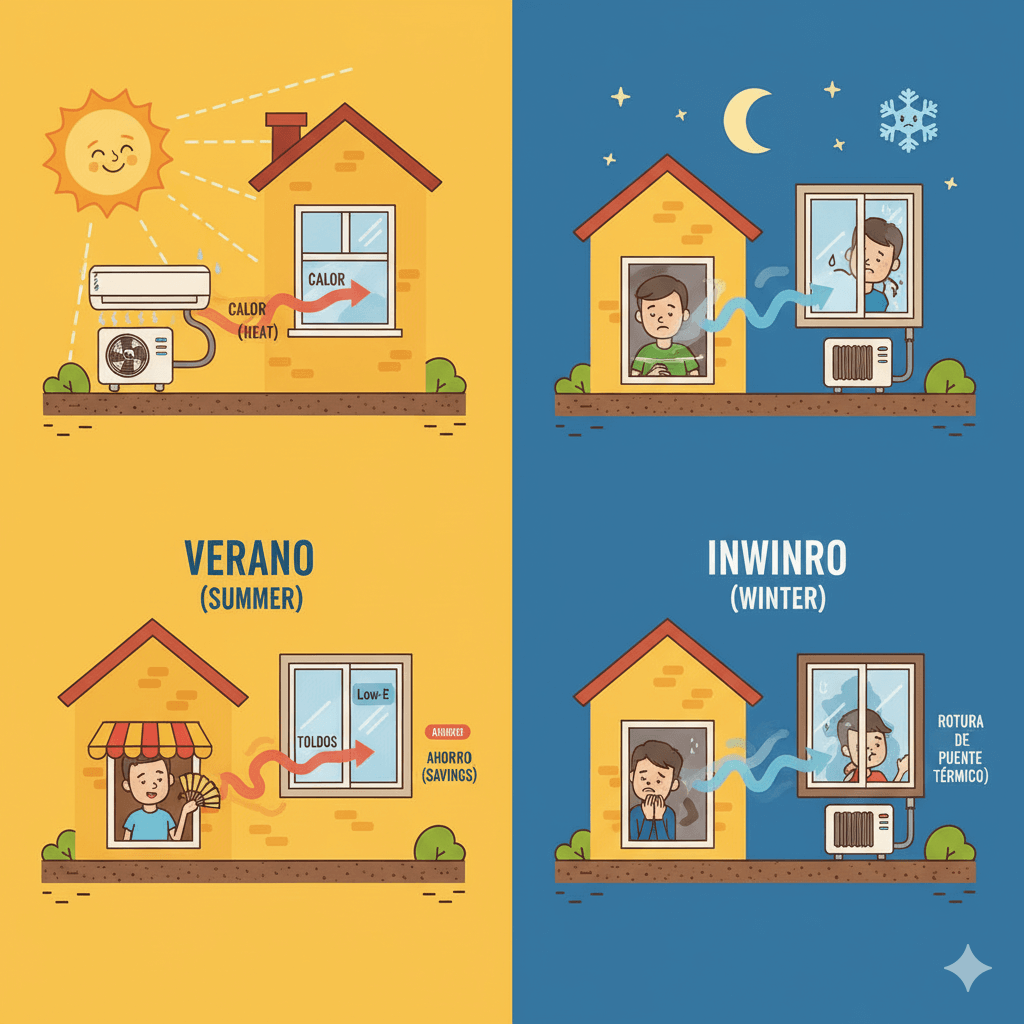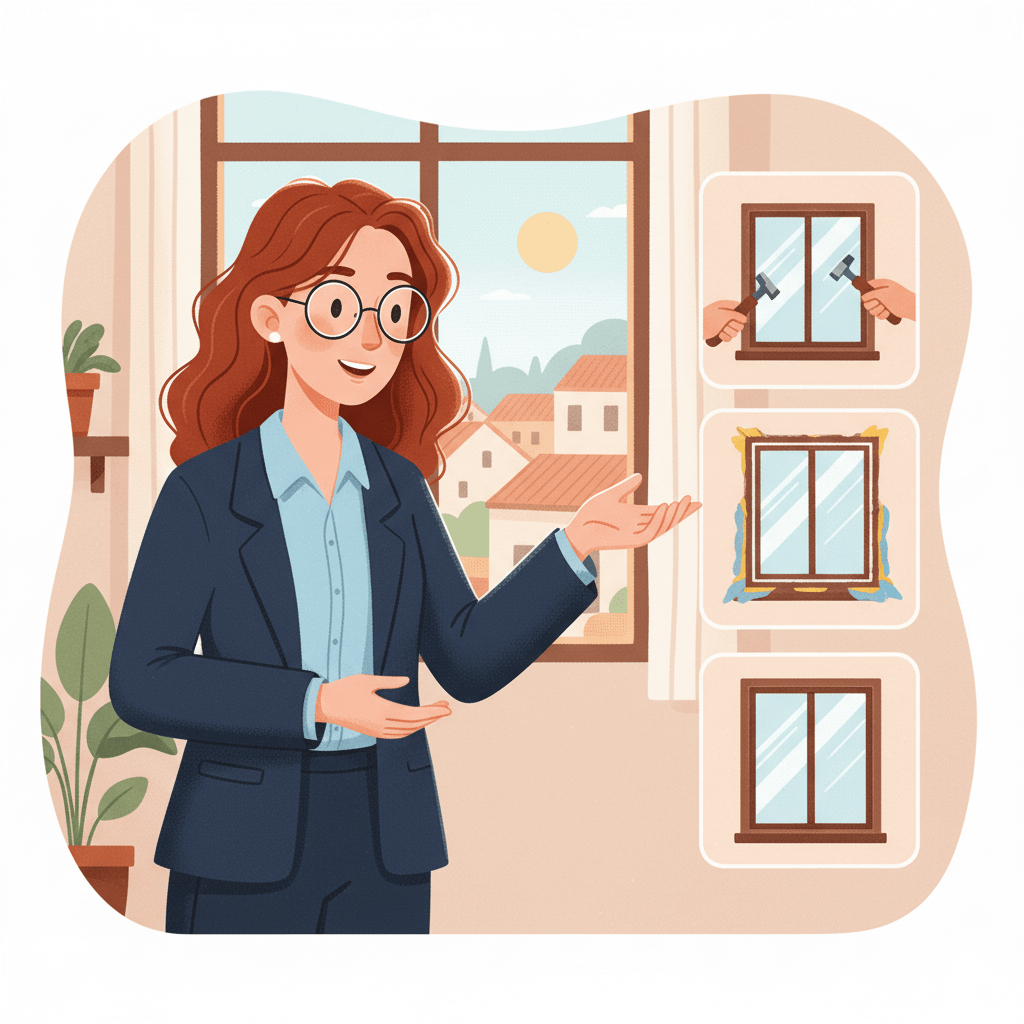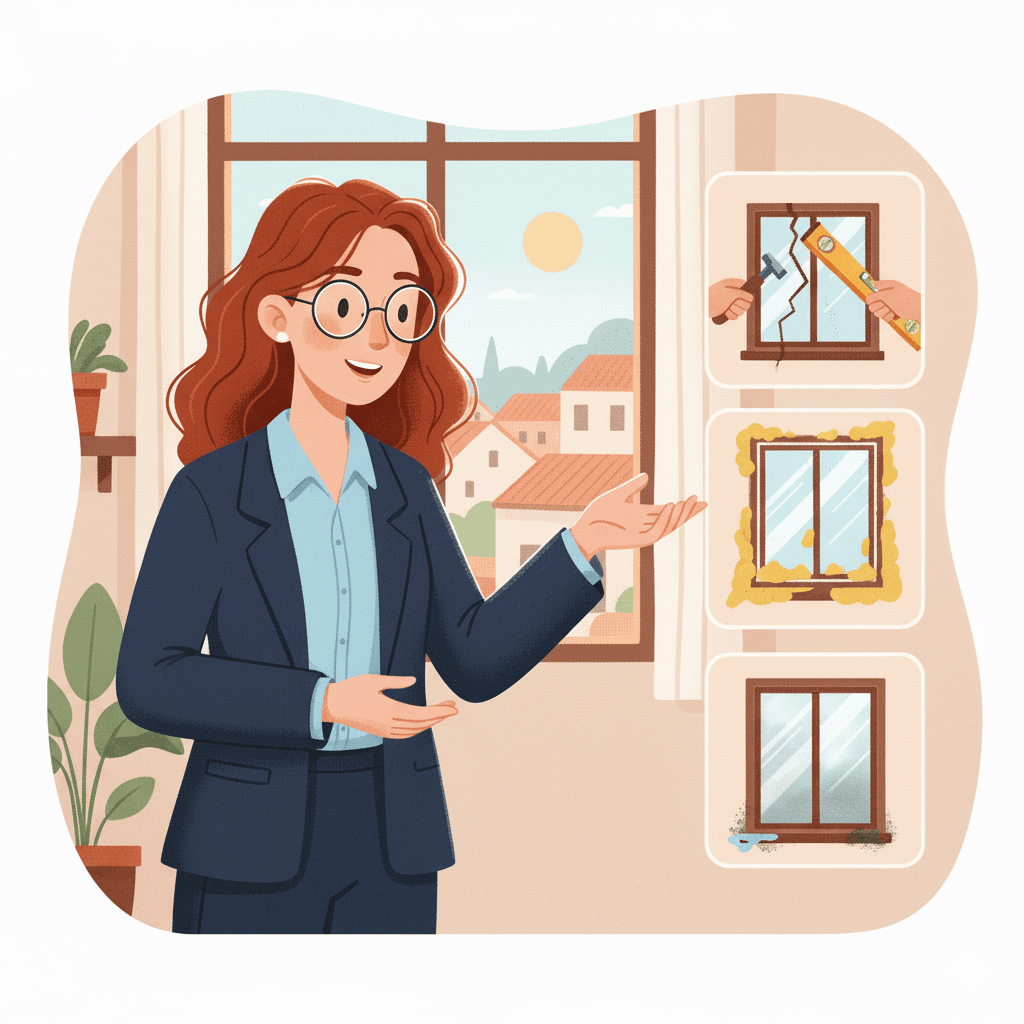Sun-protection technologies for windows: how to avoid turning your home into a greenhouse under the Spanish sun
· María Fernández · Energy efficiency and savings · 11 min read
In Andalusia, the sun shines for 3,000 hours a year, the temperature of the glass on a south-facing façade reaches 60°C, and the air conditioning bill in August can exceed €300. Proper sun protection will reduce cooling costs by 40-60% and make your home comfortable without constantly running air conditioning. We’ll explore all the technologies—from glass coatings to automatic blinds.
The Physics of Overheating—Where Does Heat Come From in Your Home?
Solar radiation consists of three components: visible light (44%), infrared radiation/heat (53%), and ultraviolet (3%). Regular glass transmits 90% of visible light and 85% of infrared radiation. This means that a 2 m² window transmits up to 1,400 watts of thermal energy into the home at midday—the same as a powerful heater.
When sunlight passes through glass, it heats the floor, walls, and furniture. These surfaces re-radiate heat in the long-wave infrared range, which the glass no longer lets out—the greenhouse effect in action. Temperatures in a room with large, unprotected south-facing windows can reach 35-40°C even when it’s 30°C outside.
In the Spanish climate, the critical period is from May to October, when the sun is high (60-75°) and shines 12-14 hours a day. West-facing windows receive the most intense radiation from 3 PM to 7 PM, when the sun is low and shines directly into the windows. It’s west-facing rooms that often become unbearably hot in the evening.
A 3.5 kW air conditioner, working to counteract solar radiation through unprotected windows, consumes 25-30 kWh per day. At a rate of €0.20/kWh, this amounts to €5-6 per day, or €150-180 per month for just one room. And this is assuming the air conditioner is powerful enough—often, even continuous operation can’t cool a room below 26-27°C.
Solar control glass—the first line of defense
Solar control glass blocks some solar radiation while remaining transparent. Key characteristics: the solar factor (g-value) indicates how much solar energy passes through the glass, and the light transmittance (LT) indicates how much visible light enters the room.
Tinted glass is the simplest solution. Metal oxides are added during production, giving the glass a gray, bronze, or green tint. The solar factor is reduced to 0.50-0.70 (versus 0.85 for regular glass). The downside is that light transmittance is proportionally reduced, making the room darker. Cost: an additional 20-30 euros/m² to the price of the double-glazed unit.
Reflective glass with a metallized coating acts like a mirror from the outside. Reflects up to 70% of solar radiation (g-value 0.20-0.30), but creates a mirror effect that can blind neighbors and is not always permitted by urban planning regulations. During the day, it provides privacy—from the outside, what’s happening inside is invisible. At night, the effect is reversed. Price: €40-60/m².
Selective glass is a high-tech solution with a metal oxide coating that selectively filters the spectrum. It transmits 60-70% of visible light but blocks up to 80% of infrared radiation. Solar factor 0.35-0.42 while maintaining natural light. Visually, it is almost indistinguishable from regular glass. Price: €60-80/m².
Electrochromic glass changes the degree of darkening on command or automatically. In the clear state, the g-value is 0.50, in the darkened state, it is 0.10. App control, smart home integration, and automatic response to sun intensity. Cons: price starting at €800/m² and the need for an electrical power supply. Only in the premium segment does it pay for itself.
Photochromic glass darkens automatically when exposed to UV radiation, like chameleon glasses. It doesn’t require electricity, but it reacts slowly (5-10 minutes) and doesn’t work behind regular glass (it doesn’t penetrate UV rays). Cost: €200-300/m². Better suited for skylights and winter gardens.
External Shading Systems – Maximum Efficiency
External systems block the sun before it heats the glass. This is 50-70% more effective than internal blinds. The heated element is located on the outside and does not transfer heat into the room.
Roller shutters (Persians) are a classic Spanish solution. Aluminum slats with foam filling provide complete shading and additional thermal insulation (reducing the window’s U-value by 30%). Modern systems with adjustable slats allow you to control the amount of light without fully raising the roller shutter.
Manual roller shutters cost from €150/m², electric ones from €300/m². Automatic systems with sun and wind sensors add €200-300 per window. The service life of high-quality roller shutters is 15-20 years, provided the mechanisms are lubricated annually.
External blinds with rotating slats – a compromise between protection and appearance. The 80-90 mm wide aluminum slats feature a Z- or C-shaped profile. A 0-90° rotation angle allows for precise light control. When closed, they reduce heat gain by 85-90%.
Motorized and automated systems cost €400-600/m². The slat position can be programmed based on the time of day or sun intensity. Integration with weather stations automatically raises the blinds in strong winds.
Awnings are retractable fabric awnings that create shade in front of the window. They are effective for large glazed areas and terraces. The impregnated acrylic fabric lasts 10-15 years and blocks 90-95% of UV radiation. The tilt angle is adjustable for optimal protection at different sun angles.
A 4x3 meter motorized awning costs €2,000-3,500. Sun and wind sensors are essential—a gust of wind can blow the awning off. Cassette systems, where the fabric is concealed in a box, are 30% more expensive but last longer.
Brisolei are fixed or movable horizontal slats above the window. A traditional Mediterranean solution that doesn’t obstruct the view. The optimal projection is 60-80 cm, and the installation angle is calculated based on the latitude of the location. For Madrid (40°), the optimal angle is 30-35°.
Aluminum brisolei cost €200-400 per linear meter. Pivoting systems are 2-3 times more expensive, but allow you to adjust the angle in winter and summer. Wooden brisolei are more beautiful but require maintenance every 2-3 years.
Internal Systems—When External Systems Are Impossible
In apartment buildings, changing the façade is often prohibited. Internal systems are less efficient (the sun has already warmed the glass), but they are better than nothing.
Blinds between panes — the slats are located inside the glass unit. They don’t collect dust, don’t interfere with opening the window, and are controlled by a magnetic handle or electric motor. They reduce the g-value to 0.30-0.40. The downside is that if they break, the entire glass unit must be replaced. The additional cost is 200-300 euros/m².
Screen roller blinds are made of fiberglass with a PVC coating. An openness factor (percentage of openings) of 1% to 10% determines the balance between protection and visibility. 5% is the optimal compromise. They reduce heat gain by 30-40% while maintaining a view of the outside. Cost: 80-150 euros/m².
Thermal blinds have a metallized coating on one side. They reflect up to 80% of thermal radiation. When closed, they reduce heat gain by 25-35%. It’s important that the curtain fits tightly against the frame, otherwise hot air will circulate. Price: 100-200 euros/m².
Glass films are a budget solution for rented properties. Sun protection films reduce the g-value to 0.35-0.50 and cost 30-60 euros/m² including installation. Cons: lifespan of 5-7 years, can cause thermal shock in the glass unit, and are difficult to remove. Mirror films are often prohibited by community regulations.
Automation — Smart Sun Protection
Automated sun protection systems can save an additional 20-30% on air conditioning costs by reacting to changing conditions without human intervention.
Solar radiation sensors measure solar radiation intensity and activate the shutters when a threshold (usually 300-500 W/m²) is exceeded. More advanced systems take into account the angle of incidence of solar rays and close only those windows exposed to sunlight. The system costs 300-500 euros.
Weather stations add temperature, wind, and rain sensors. When wind speeds exceed 40 km/h, awnings automatically retract. When it rains, the motorized windows close. A complete system costs 500-800 euros.
Smart home scenarios coordinate the operation of all systems. In the morning, the eastern blinds open to let in natural light, and during the day, the southern and western blinds close. In the evening, everything opens for ventilation. Integration with the climate control system turns off the air conditioning in closed rooms.
App control allows you to monitor the security system remotely. Left and forgot to close the blinds? No problem. Coming home and want to keep cool? Close the security system an hour before. KNX or Z-Wave systems provide reliable communication.
Passive Architectural Solutions
Pergolas with climbing plants provide natural protection that changes with the seasons. Deciduous plants (grapes, wisteria) provide shade in summer and let in sun in winter. They reduce the temperature by 3-5°C and add humidification. Cons: 2-3 years for development, maintenance, and fallen leaves.
Extended canopies and balconies on the upper floors protect the lower windows. The optimal overhang for the Spanish latitude is 80-100 cm. Concrete canopies can be coated with white paint with a high albedo to reflect radiation.
Light-colored trim around windows reflects some of the radiation. White slopes and window sills heat up 10-15°C less than dark ones. Special thermal paints with ceramic microspheres reflect up to 90% of infrared radiation.
Green walls are vertical greening of the façade. They reduce wall temperatures by 5-8°C, but require irrigation and maintenance. Modular systems cost from 200 euros/m² but create a unique microclimate.
A comprehensive approach for different types of rooms
Living room with panoramic windows facing south:
- Selective glass (g-value 0.35)
- External roller shutters with automatic control
- Internal screen 5% blinds for added comfort
- Investment: €3,000-4,000 per 10 m²
- Savings: €400-500/year
Bedroom facing west:
- Glass with moderate protection (g-value 0.50)
- Roller shutters for complete blackout
- Automatic control with timer
- Investment: €1,500-2,000 per 3 m²
- Savings: €150-200/year
Kitchen facing east:
- Regular Low-E glass (beneficial to the morning sun)
- Internal adjustable blinds
- Investment: €300-400 for 2 m²
- Savings: minimal, but higher comfort
Home Office:
- Selective anti-glare glass
- External blinds with precise adjustment
- 3% screen blinds for working with a monitor
- Investment: €1,000-€1,500 per 3 m²
- Increased productivity: priceless
Regional Specifics of Spain
Andalusia (Seville, Cordoba, Granada) — extreme heat, 3,000+ hours of sun per year:
- External sun protection systems are required
- Selective glass on all sides except north
- White or light-colored roller shutters (dark ones heat up to 70°C)
- ROI of sun protection: 2-3 years
Mediterranean (Valencia, Alicante, Murcia) — heat + sea breeze:
- Combination of selective glass and awnings
- Corrosion-resistant materials (class C4)
- Automation with a wind sensor is required
- ROI: 3-4 years
Central Spain (Madrid, Valladolid) — Winter/summer contrasts:
- Multifunctional glass
- Adjustable systems (blinds, rotating slats)
- A balance between summer and winter is important Efficiency
- ROI: 4-5 years
North (Bilbao, Santander) — moderate climate:
- Light protection (tinted glass) is sufficient
- Internal systems are usually sufficient
- Focus on rain protection, not sun protection
- ROI: 7-10 years
Mistakes that cost money
Dark roller shutters on a south-facing façade heat up to 70°C and radiate heat even when closed. White or light gray ones are 30% more efficient.
Lack of ventilation gap between the shutter and the glass. Hot air should escape from the top, and cold air should enter from the bottom. A 5-10 cm gap reduces the temperature by 5-7°C.
Savings on automation based on manual operation. Reality: no one will lower/raise their blinds 4 times a day. Automation pays for itself through optimal use.
Equal protection for all windows. North-facing windows require minimal protection, east-facing windows require minimal protection, and west-facing windows require maximum protection. This differentiated approach saves 30-40% of your budget.
Payback Calculation: A Real-World Example
100 m² apartment in Valencia, 15 m² of glazing (8 m² south, 4 m² west, 3 m² east):
Without protection:
- 7 kW air conditioner running 8 hours/day
- Consumption: 40 kWh/day × 150 days = 6,000 kWh
- Expenses: €1,200/season
With comprehensive protection:
- Selective glass facing south and west: €1,000
- External blinds facing south: €2,000
- Awning on west-facing balcony: €1,500
- Screen blinds facing east: €300
- Automation: €800
- Total investment: €5,600
Result:
- 60% load reduction
- Air conditioner runs 4 hours/day
- Consumption: 2400 kWh/season
- Costs: €480/season
- Savings: €720/year
- Payback: 7.8 years
Considering rising electricity prices (5-7% per year) and improved comfort, the actual payback is 6-7 years. With a system lifespan of 15-20 years, this is a worthwhile investment.




